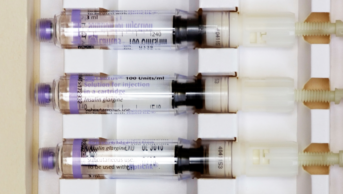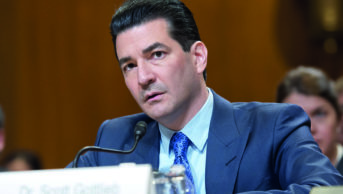
Shutterstock.com
Drug regulators have noticed a proliferating problem. Around the world, various regional regulators are applying different naming conventions for biosimilars. So several regulators asked the World Health Organization (WHO) — which has responsibility for giving drugs their generic names under the International Non-proprietary Name (INN) programme — to devise a global nomenclature for biosimilars.
Biosimilars are biological medicines that are highly similar to an already authorised reference medicine yet priced more competitively. The biosimilars market is expected to grow over the next few years as originator products lose their exclusive licence, with payers seeing them as an important way to reduce costs on already stretched healthcare budgets. More than 30 biologics with combined sales of US$51bn are said to be losing patent protection by 2015.
The global biosimilars market was worth almost US$2bn in 2014, according to BCC Research, a technology market research company based in Wellesley, Massachusetts, and the market is expected to grow to nearly US$4bn by 2019. Since 2013, the WHO has been working on a proposal that will provide a unique identification code — called a Biological Qualifier (BQ) — for all biological medicines, including biosimilars, and it hopes to complete its consultation process by October 2015.
“This is about patient safety,” says Raffaella Balocco-Mattavelli, manager of the INN programme, who is working closely on the project. A global unified naming system is central to ensuring the safe use of biosimilars — from the identification of the product in the clinical setting to its traceability after it reaches the patient, say its supporters.
The proposed Biological Qualifier scheme was set out in a July 2014 draft, which was discussed at a closed meeting in Geneva on 13–15 April 2015 — the WHO’s 60th consultation on INNs for pharmaceutical substances. The majority of respondents to the WHO proposal were in favour of it, according to Balocco-Mattavelli.
However, not all stakeholders are supportive of the plans. Ahead of a Biological Qualifier Comments Review meeting in Geneva on 16 June 2015, several organisations have spoken out against the BQ system.
Naming convention
Biosimilar products can be relatively small molecules, such as human insulin, or complex medicines, such as monoclonal antibodies (see ‘Biosimilars authorised by the European Medicines Agency’). They have been called different things too, including similar biotherapeutic products (SBPs), follow-on biologics and subsequent entry biologics. The WHO defines them as: “a biotherapeutic product that is similar in terms of quality, safety, and efficacy to an already licensed reference biotherapeutic product.”
However, biosimilars are derived from living organisms and demand a more complex regulatory pathway from simple generic medicines. This is because of the difficulty of establishing comparability between products. This is down to various factors, including the product’s complex structure and manufacturing process, the difficulty in achieving consistency among batches, and in their complex long-term clinical effects. Biological active substances account for more than 40% of applications to the INN programme and the percentage is increasing, says the WHO.
Now, as an increasing number of biosimilars are approved, a variety of naming systems have been adopted in different jurisdictions. In several places, a distinctive non-proprietary identifier is added as a qualifier. In Japan, for example, the qualifier is simply the code ‘BS’, such as ‘epoetin alfa BS’. In Australia, ‘epoetin alfa’ was registered by the Therapeutic Goods Administration (TGA) as ‘epoetin lambda’.
In other examples, the company is identified in different ways: ‘Filgrastim Hexal’ in Europe; ‘Tevagrastim Teva’ (for Laboratorio Teva) and ‘Filgrastine Blau’ (for Laboratório Blau Farmacêutica) in Brazil; and ‘Filgrastim-sndz’ in the United States (for a ‘Sandoz’ marketed product).
In other countries, a proprietary name alone is used, in South Korea, Celltrion’s biosimilar of Roche’s trastuzumab is called ‘Herzuma’; and Celltrion’s biosimilar of Johnson & Johnson’s Remicade (infliximab) is branded as both ‘Remsima’ and, in Europe specifically, as ‘Inflectra’.
However, under the WHO naming proposal, the BQ would consist of a four-letter code suffix assigned at random, resulting in names such as ‘filgrastim-bcdf’ and ‘filgrastim-wxyz’. The code would also be attached to the manufacturing site where the biosimilar is made, which has been criticised by industry groups. For instance, a company could have two different codes for the same biosimilar product manufactured at two different sites.
Such a suffix allows for 160,000 combinations of the four letters (excluding vowels). “This will provide sufficient flexibility for the foreseeable future,” the WHO contends. The proposed BQ scheme would apply to all biologicals assigned an INN and it would be applied retrospectively. A database would be created to hold all the codes issued. The BQ scheme would be universal but complementary to systems in place nationally, and its adoption by regulatory agencies would be voluntary.
The additional layer of labelling involved has been criticised by the European Biosimilars Group (EBG), part of the European Generic and Biosimilar Medicines Association, as increasing the risk of confusion and pharmacovigilance errors. However, the WHO proposal justifies its use as the means to ensuring that, irrespective of the names given nationally, each biosimilar can be fully differentiated and readily traced to its origin and even manufacturing process.
Industry concerns
The generics industry has been one of the most vocal critics of the WHO’s proposal. The EBG openly challenged it in a policy document[1] presented at the WHO consultation meeting in April 2015.
“The current system works well; the introduction of a special system for a specific class of products disrupts this well-working unified system,” said the EBG. “Physicians and pharmacists will be confused as to what to do with the new, unknown identifier. This increases the risk of prescription errors, dispensing errors, medication errors and adverse reaction reporting errors.”
The EBG says it introduces another identification layer, which can only increase the risk of error, thereby hampering pharmacovigilance. Essentially, “a trade name or the combination of the INN and company name would suffice”, says EBG chairman Joerg Windisch, of Sandoz Biopharmaceuticals.
The US Generic Pharmaceutical Association (GPhA) is also not clear why the addition of a BQ to the INN would provide any additional value as it thinks the current INN naming system is simple and should not be changed, according to a WHO document published in March 2015.
The GPhA also thinks the proposed BQ scheme should not have a manufacturing site designation, but if a modifier is to be used, the clearest format would be the marketing authorisation holders’ (MAH’s) name.
“Safety is enhanced by globalisation of non-proprietary names, which need to be kept simple. The proposed BQ will not necessarily increase safety as products are tracked with batch numbers and not a drug substance related BQ. A four letter code will be difficult to remember whilst application to the manufacturing site will cause confusion as some drug substances are manufactured at multiple sites,” according to the document.
The GPhA reiterated these views in response to the US Food and Drug Administration’s (FDA) Zarxio approval in March 2015, arguing that its ‘filgrastim-sndz’ name respects safety and competitiveness considerations.
By contrast, were unique INNs to be imposed on biosimilars, it would divorce the biosimilar from its shared regulatory history with the reference originator product on which its approval is fundamentally based, thereby reducing its safety, the GPhA argues in a position statement.
“A biosimilar must have the same clinical pharmacology as the reference product, and by definition does not contain a new active ingredient. With a different INN, a prescribing physician may legitimately conclude that the active ingredients are different and so not recognise that the biosimilar and its related brand product have the same safety and efficacy history,” it says. “As a result, physicians may prescribe two highly similar products to the same patient because they have different INNs, yet treat the same medical conditions, resulting in double dosing.”
Reducing competition
In terms of competition, it argues that unique INN names would make for a less competitive biologic marketplace. “Not only would they create unnecessary confusion among healthcare providers and patients, but states will not allow the substitution of a branded product with a biosimilar of the same ingredient if biosimilars have unique INNs,” the GPhA states.
The IFPMA, the international pharmaceutical industry association which represents research and development (R&D) companies, also thinks the BQ should be linked to the MAH.
For BIOTECanada, a Canadian biotechnology industry association, a naming scheme for all biologics, including biosimilars, is needed to address the “misconceptions and prescribing and recording practices” of physicians. In a survey, published in March 2015, only one in ten respondents were “very familiar” with biosimilars, while 62% thought that two medicines with the same non-proprietary name could be expected to have the same clinical effect. As for the naming system, 79% said Health Canada should insist on a distinct non-proprietary name for every biologic or biosimilar approved.
The International Pharmaceutical Federation (FIP), the global body representing pharmacists, has revealed little about its views on the BQ proposal.
Luc Besançon, the general secretary and CEO of FIP, says: “There is a strong interest in being able to identify precisely the biosimilars to be included on the formularies, or dispensed to a patient, [and the WHO proposal is] one way to respond to this need.” The subject is “complex, as it involves scientific, economic, intellectual property, practical and safety considerations”, and FIP will be addressing these concerns in its response, he said.

Source: FIP
Luc Besançon, general secretary of the International Pharmaceutical Federation, the global body representing pharmacists, says there is a strong interest in being able to identify precisely the biosimilars to be included in formularies or dispensed to patients
The FDA is drawing up its own naming system and intends to issue its draft guidance on the ‘non-proprietary naming for biological products’ in 2015.
When the FDA approved Sandoz’s Zarxio — its first biosimilar — it used a specific BQ-modelled suffix (as opposed to the WHO’s randomly-generated BQ model) to identify the manufacturer. However, while naming the biosimilar as ‘filgrastim-sndz’, the FDA has reiterated that “the provision of a placeholder non-proprietary name for this product should not be viewed as reflective of the agency’s decision on a comprehensive naming policy for biosimilars and other biological products.”
Michael Reilly, executive director of the US Alliance for Safe Biologic Medicines (ASBM), which represents physicians, pharmacists, patients, researchers and manufacturers, commends the WHO for recognising the need for distinguishable naming for all biologics, including biosimilars.
“Distinguishable naming allows the keeping of an accurate patient record, and reduces the likelihood of inadvertent or inappropriate substitution. It aids in long-term tracking of safety and efficacy, and ensures that any adverse events are attributed to the correct product, which is especially important with medicines benefitting from an abbreviated approval process, [and] promotes manufacturer understanding of and accountability for their products,” he says.
Referring to the FDA’s Zarxio move, Reilly explains that the ASBM and more than 70 other groups had petitioned the regulator in August 2014 to follow the WHO’s lead by supporting distinguishable naming in general and the BQ proposal in particular, and were pleased that its Zarxio approval included the differentiating suffix ‘-sndz’ to enable clear product identification.
“While the proposed BQ suffix consists of random letters and is tied to the manufacturing facility, physicians have expressed to ASBM that a suffix tied to the name of the entity ultimately responsible for the product’s safety and efficacy — its manufacturer or MAH — would be more useful,” Reilly said.
He suggests that this will be the crux of the FDA’s position on the BQ model, despite the agency’s reluctance to comment.
Meanwhile, the European Medicines Agency (EMA) thinks its current naming system is fine. The EMA’s current biologicals naming policy is governed by EU Directive 2001/83/EC, which requires the use of the INN in the description of active substances in medicinal products, in line with the WHO INN policy for biologicals.
In addition to the INN, the EU requires either an invented name (brand name) or INN plus a company identifier, to create the unique name of the biosimilar. For example, for INN infliximab, it has the invented name ‘Remsima’; and for the INN filgrastim, it has ‘Filgrastim Hexal’.
According to a spokesperson, the WHO proposal is of interest to a number of global regions, but in the EU, “the naming system and requirement to report any adverse reactions by invented name and batch number are robust [and] we consider at this stage that there is no need to further distinguish products at the level of the active substance in the EU”.
Other regulators, such as Australia’s TGA, has put on hold new biologics naming plans to accommodate the shift in WHO policy. In January 2015, the TGA explained that it had previously proposed that all biosimilars in Australia have distinguishable names, consisting of: the reference product Australian Biological Name (ABN), thereby identifying the product with which the biosimilar has demonstrable comparability, plus a biosimilar identifier, consisting of the prefix sim(a)- and the three-letter INN code issued by the INN Committee, in line with draft WHO policy at the time.
However, the WHO BQ proposal unveiled in July 2014 superseded this model, forcing the TGA to put its naming system on hold. “In the interim, biosimilars will use the ABN without a specific biosimilar identifier suffix. For example, a biosimilar to the reference product Neupogen filgrastim would be named ‘TRADENAME’ filgrastim,” it said in January 2015.
Given that the biosimilars sector could be worth up to US$25bn by 2020, equivalent to 4–10% of the projected US$250bn biologics market, getting their names right is going to be crucial in future years.
| Biosimilars authorised by the European Medicines Agency | |||
|---|---|---|---|
| Name | Active substance | Therapeutic area | Date of authorisation |
| Source: European Medicines Agency | |||
Omnitrope | somatropin | Dwarfism (pituitary), Prader-Willi syndrome, Turner syndrome | 12/04/2006 |
Epoetin Alfa Hexal | epoetin alfa | Anaemia, cancer, chronic kidney failure | 28/08/2007 |
Binocrit | epoetin alfa | Anaemia, chronic kidney failure | 28/08/2007 |
Abseamed | epoetin alfa | Anaemia, cancer, chronic kidney failure | 28/08/2007 |
Silapo | epoetin zeta | Anaemia, autologous blood transfusion, cancer, chronic kidney failure | 18/12/2007 |
Retacrit | epoetin zeta | Anaemia, autologous blood transfusion, cancer, chronic kidney failure | 18/12/2007 |
Tevagrastim | filgrastim | Cancer, hematopoietic stem cell transplantation, neutropenia | 15/09/2008 |
Ratiograstim | filgrastim | Cancer, hematopoietic stem cell transplantation, neutropenia | 15/09/2008 |
Biograstim | filgrastim | Cancer, hematopoietic stem cell transplantation, neutropenia | 15/09/2008 |
Zarzio | filgrastim | Cancer, hematopoietic stem cell transplantation, neutropenia | 06/02/2009 |
Filgrastim Hexal | filgrastim | Cancer, hematopoietic stem cell transplantation, neutropenia | 06/02/2009 |
Nivestim | filgrastim | Cancer, hematopoietic stem cell transplantation, neutropenia | 08/06/2010 |
Remsima | infliximab | Psoriatic arthritis, rheumatoid arthritis, ulcerative colitis, Crohn’s disease, psoriasis, ankylosing spondylitis | 10/09/2013 |
Inflectra | infliximab | Psoriatic arthritis, rheumatoid arthritis, ulcerative colitis, Crohn’s disease, psoriasis, ankylosing spondylitis | 10/09/2013 |
Ovaleap | follitropin alfa | Anovulation | 27/09/2013 |
Grastofil | filgrastim | Neutropenia | 18/10/2013 |
Bemfola | follitropin alfa | Anovulation | 27/03/2014 |
Abasaglar (previously Abasria) | insulin glargine | Diabetes mellitus | 09/09/2014 |
Accofil | filgrastim | Neutropenia | 18/09/2014 |
References
[1] European Biosimilars Group. Considerations on WHO’s BQ proposal. 13 April 2015.


